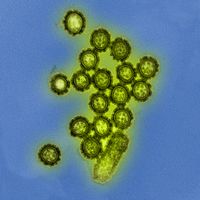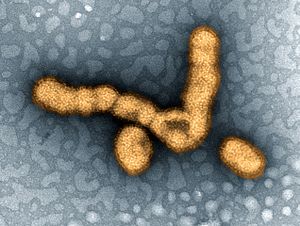Influenza A virus subtype H1N1
Influenza A virus subtype H1N1 is the subtype of influenza A virus that was the most common cause of human influenza (flu) in 2009, and is associated with the 1918 outbreak known as the Spanish Flu. It is also called swine flu by the media.
H1N1 strains caused a small percentage of all human flu infections in 2004–2005.
In June 2009, the World Health Organization (WHO) declared a new strain of swine origin, H1N1/09 as a pandemic. It spread worldwide and caused about 17,000 deaths by the start of 2010. On August 10, 2010, the WHO declared the H1N1 influenza pandemic to be over.[1]
Research Pertaining To ME/CFS[edit | edit source]
- 2015, Chronic fatigue syndrome/myalgic encephalomyelitis (CFS/ME) is associated with pandemic influenza infection, but not with an adjuvanted pandemic influenza vaccine.[2]
Pandemic influenza A (H1N1) infection was associated with a more than two-fold increased risk of CFS/ME. We found no indication of increased risk of CFS/ME after vaccination. Our findings are consistent with a model whereby symptomatic infection, rather than antigenic stimulation may trigger CFS/ME.[2]
Learn more[edit | edit source]
See also[edit | edit source]
References[edit | edit source]
- ↑ "Influenza A virus subtype H1N1". Wikipedia. August 24, 2018.
- ↑ 2.0 2.1 Magnus, Per; Gunnes, Nina; Tveito, Kari; Bakken, Inger Johanne; Ghaderi, Sara; Stoltenberg, Camilla; Hornig, Mady; Lipkin, W. Ian; Trogstad, Lill (November 17, 2015). "Chronic fatigue syndrome/myalgic encephalomyelitis (CFS/ME) is associated with pandemic influenza infection, but not with an adjuvanted pandemic influenza vaccine". Vaccine. 33 (46): 6173–6177. doi:10.1016/j.vaccine.2015.10.018. ISSN 1873-2518. PMID 26475444.



